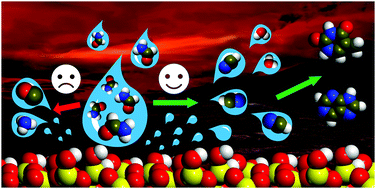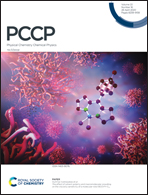A quantum mechanical study of dehydration vs. decarbonylation of formamide catalysed by amorphous silica surfaces†
Abstract
Formamide is abundant in the interstellar medium and was also present during the formation of the Solar system through the accretion process of interstellar dust. Under the physicochemical conditions of primordial Earth, formamide could have undergone decomposition, either via dehydration (HCN + H2O) or via decarbonylation (CO + NH3). The first reactive channel provides HCN, which is an essential molecular building block for the formation of RNA/DNA bases, crucial for the emergence of life on Earth. In this work, we studied, at the CCSD(T)/cc-pVTZ level, the two competitive routes of formamide decomposition, i.e. dehydration and decarbonylation, either in liquid formamide (by using the polarization continuum model technique) or at the interface between liquid formamide and amorphous silica. Amorphous silica was adopted as a convenient model of the crystalline silica phases ubiquitously present in the primordial (and actual) Earth's crust, and also due to its relevance in catalysis, adsorption and chromatography. Results show that: (i) silica surface sites catalyse both decomposition channels by reducing the activation barriers by about 100 kJ mol−1 with respect to the reactions in homogeneous medium, and (ii) the dehydration channel, giving rise to HCN, is strongly favoured from a kinetic standpoint over decarbonylation, the latter being, instead, slightly favoured from a thermodynamic point of view.

- This article is part of the themed collection: 2020 PCCP HOT Articles


 Please wait while we load your content...
Please wait while we load your content...